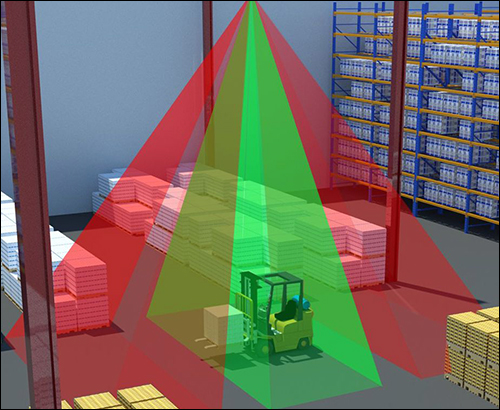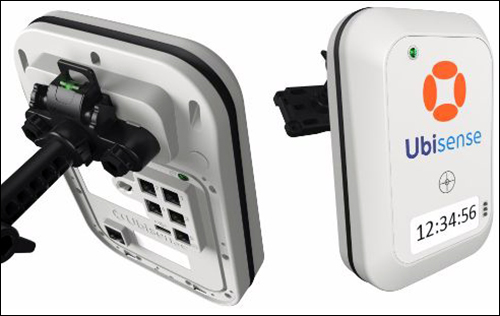May 11, 2016Implementing a real-time location system (RTLS) within a factory or at another site typically requires the installation of a network of readers and software integrated with a user's own management software. This makes the installation daunting for companies that want a quick and inexpensive solution, especially if the issue they hope to resolve with the technology is small or isolated.
At last week's RFID Journal LIVE! conference and exhibition, Ubisense, a U.K.-based global provider of location-based solutions, released AngleID, an RTLS product that can be installed within a matter of minutes, according to Jay Cadman, Ubisense's marketing director. The system, which can determine a tag's location within five configurable zones, was originally designed for use in industrial and manufacturing environments. The company reports that it exhibited at this year's LIVE! event in order to investigate other potential AngleID applications across logistics, retail and health care, and that it identified many new use cases and opportunities.
Cadman says that his company's industrial and manufacturing customers had been requesting a simple, standalone solution that could quickly and accurately identify the locations of equipment, tools or other assets without the need for IT integration or cabled reader infrastructure.
AngleID, which works with Ubisense's Dimension4 active ultra-wideband (UWB) RFID tags, is intended to be a solution that a user with little technical know-how can install within only a few minutes, says Jon Heathcote, Ubisense's product manager for software solutions. The AngleID sensor (reader), powered via a Power-over-Ethernet connection, is intended to interface with a user's existing PLC or standalone computer. The tags and reader, which operate in the 6 to 8 GHz frequency band, offer approximately 10 times the read range of passive UHF RFID readers and tags, Heathcote says.
The Dimension4 Tool tag comes in the form of a head unit only—powered either by a tool itself, or via a battery with an average lifespan of five years. Ubisense's Minitag is smaller and offers a two-year battery life, while the battery in its Industrial tag can provide more than 10 years' worth of usage.
To configure and operate an AngleID sensor, a user connects the device to a Windows-based computer via an Ethernet cable, then simply uses the sensor software running on the computer to map out zones by clicking and dragging the edges of each zone to define its particular read area. The sensor offers a 150-foot read range. A single sensor can cover up to a 15,000-square-foot area, Cadman says, while additional sensors would increase read range or offer greater flexibility in cluttered environments.
The AngleID sensor has a phased array antenna that captures tags' transmission pulses. The device measures the angle from each tag to the reader (the angle accuracy is 1.5 degrees) and monitors the tag's entry and exit for up to five different zones. The reader uses a text-based TCP/IP protocol or open protocol to report this data to the computer, Cadman notes. In the future, Ubisense plans to add support for other protocols, such as Ethernet/IP and Profinet. "All this is performed on the reader itself," he states, "with no need for server-based middleware or processing."
At a busy intersection within a distribution center, a single AngleID sensor could be installed on the ceiling, with zones drawn out around that intersection. The sensor could detect a forklift vehicle fitted with a Ubisense tag, and the user's network could forward that location data to a PLC or computer installed there. As the vehicle moved from one zone to the next, the system would capture and store that movement. If three-dimensional tracking were required—to detect how high the vehicle's fork is lifted, for example—a second sensor could be installed on a wall.
Similarly, sensors could be installed at dock doors to manage vehicles or containers being moved through those doors. The system could also monitor employees—for instance, identifying how many workers move through a turnstile, as well as when this occurs.

The sensor can also assist with automated manufacturing systems. By attaching a Ubisense tag to a turntable, a company could ensure that the turntable is in its proper position, based on the zone in which the tag is located, before the next step of an assembly process begins.
If a crane is delivering a product to a workstation, for instance, a tag on that crane could enable a PLC to identify when the crane has released the product so that the assembly process can then proceed. In a manufacturing area in which only certain tools can be operated with specific products or processes, the system could identify the zone in which every tagged tool is located. If a tool enters a zone in which it does not belong, the AngleID software could trigger an alert by, for instance, lighting up a warning indicator at the PLC.
"The increasing complexity of the manufacturing process is driving a lot of this," Heathcote says. Another key driver, he adds, is the rise in Industry 4.0 initiatives.
The sensor is available in three different enclosures that vary according to IP rating. The IP30 version measures 20 centimeters by 14 centimeters by 6.5 centimeters (8.0 inches by 5.5 inches by 2.6 inches) in size and weighs 625 grams (22 ounces) The IP54 version is 20 centimeters by 14 centimeters by 9.5 centimeters (8.0 inches by 5.5 inches by 3.7 inches) in size and weighs 745 grams (26.5 ounces). And the IP65 version measures 21 centimeters by 14 centimeters by 9.5 centimeters (8.3 inches by 5.5 inches by 3.7 inches) in size and weighs 775 grams (27.5 ounces). Ubisense is now taking orders for the readers with built-in firmware, with first shipments slated to take place on June 1, 2016.
The retail price for the AngleID sensor starts at $4,950 apiece. Ubisense will sell the sensor and tags through such companies as industrial tool providers and RFID systems integrators. According to Cadman, the firm is initially focused on the North American and European markets, with a planned expansion to follow into Japan, China and Korea.




